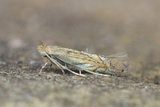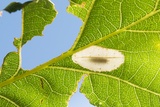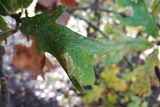Phyllonorycter quercifoliella (Zeller, 1839) Species
Last modified: Dec. 10, 2025, 5:49 p.m.
A very common species throughout Belgium.
Details
- Classification
- Family: Gracillariidae > Subfamily: Lithocolletinae > Genus: Phyllonorycter > Species: Phyllonorycter quercifoliella
- Vernacular names
- Gewone eikenvouwmot (NL), Common oak midget (EN), Gemeine Eichen-Faltenminiermotte (DE)
- First mention in Belgium
- De Sélys-Longchamps E. 1844. Énumération des insectes Lépidoptères de la Belgique. — Mémoires de la Société royale des Sciences de Liége 2: 1–35. On page 25 (as Elachista quercifoliella Fischer). view page
- Status
-
Native
Distribution
Imago
Head ochreous or brownish; forewing ground colour golden, olive-ochreous, whitish pattern consisting of a very long, narrow, basal line, finely edged with brown scales; four costal and three dorsal striae, finely edged with brown scales on the basal side. A distinct, small, black dot in the apical area.
Mine
A semi-circular, oval, or sometimes long tentiform mine with a variable length (10–22 mm) on the underside of a leaf, very often situated in an axil. One strong longitudinal fold in the centre of the mine. The upper side is visible as a yellowish or white patch, at first with a green island, but when all the parenchyma is consumed, completely discoloured. The black frass is usually scattered all over the mine.
See also gracillariidae.net and bladmineerders.be.
Cocoon/pupa
The last instar of the summer generation makes a whitish, oval cocoon, which is completely covered with the black frass, and attached to the roof of the mine. The last instar of the autumn generation makes a tough, white, oval cocoon, which is only covered at the sides with black frass, and attached both to the roof and the bottom of the mine. Pupa brown to very dark brown.
Bionomics
The species hibernates in the pupal stage, inside the cocoon between fallen leaves among leaf litter on the ground. After the emergence of the adult, the pupal skin protrudes from the mine.
The adults rest on tree trunks, during the day; they are active at dusk and later come to light.
Flight periods
The adults fly in two generations a year in April–May and again in August–September.
Observed on
- Host plant (species):
- Quercus robur and Quercus petraea
- Host plant (genera):
- Quercus
The species is monophagous on Quercus, with a preference for Quercus robur, but it has also been found on Quercus petraea.
Habitat
Forest edges, borders of streets, meadows and gardens.



